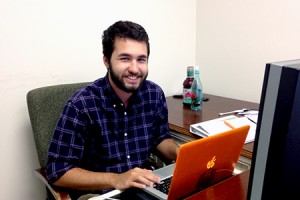 Michael Gorman is a senior as a Mechanical Engineering major at Syracuse University. He is originally from Maui, but has lived in New Zealand and Florida, in addition to traveling to over 35 countries. He is very interested in innovation and design and would one day like to design something of his own. He has a primary interest in the space program and has been passionate about it since he was a kid. He hopes to work with a company that actively designs products or create his own business. In his free time, Michael enjoys working with computers, watching movies, playing sports, and hanging out with friends.
Michael Gorman is a senior as a Mechanical Engineering major at Syracuse University. He is originally from Maui, but has lived in New Zealand and Florida, in addition to traveling to over 35 countries. He is very interested in innovation and design and would one day like to design something of his own. He has a primary interest in the space program and has been passionate about it since he was a kid. He hopes to work with a company that actively designs products or create his own business. In his free time, Michael enjoys working with computers, watching movies, playing sports, and hanging out with friends.
Project Title: Cooling a Solar Telescope: Plate Coil Thermal Analysis
Host Organization: Daniel K. Inouye Solar Telescope (DKIST)
Mentor: Chriselle Galapon
Co-Mentors: LeEllen Phelps and Guillermo Montijo Jr.
Project Abstract:
The extreme climate of Haleakal? requires the observatories to actively adapt in order to produce the best possible images. The telescope structure needs to be close to ambient temperature or the images become blurred and unusable. The Daniel K. Inouye Solar Telescope is a unique observatory as it will be actively observing during the day. This means that it will not only need to keep a constant temperature during the day, but also during the night so as not to radiate stored heat to the other telescopes while they are in use. To accomplish this feat, plate coil panels will be installed on the DKIST enclosure that are designed to keep the temperature close to that ambient temperature (between +0°C and -4°C). To ensure this, a test rig has been installed at the summit of Haleakal?. The project’s purpose was to verify that the plate coil panels are capable of maintaining this temperature and involved collecting data sets of various variables including pressures, temperatures, flows of coolant, solar radiations and wind velocities during typical operating hours. Using MATLAB, a script was written to observe the plate coil’s thermal performance. The plate coil did not perform as expected, achieving a surface temperature that was generally 2°C above ambient temperature, which indicates that the coolant pumped through the plate coil may not be set to a low enough temperature at this time. Calculated heat depositions from the model were within 25% of the measured design data, a reasonable agreement given the fact that many simplifying assumptions were used in the model. It is recommended to do additional tests at later hours in the day for completeness and to use a larger chiller for the plate coil or to set the coolant flowing through the plate coil to a lower temperature to achieve the desired cooling.